Cape Wools: Implementation Plan for International Business in Malaysia
VerifiedAdded on 2022/09/02
|14
|3219
|10
Report
AI Summary
This report presents a comprehensive international business plan for Cape Wools' expansion into the Malaysian market. It begins with an executive summary highlighting the volatile nature of the international business environment and the opportunities for expansion. The report analyzes market entry strategies, focusing on direct exporting and licensing, with a comparative analysis to determine the most viable option. It then outlines marketing strategies, including target market identification (elite consumers), a detailed 4Ps marketing mix (product, price, place, promotion), and a financial plan with sales forecasts, overhead expenses, and a projected income statement. The report concludes by summarizing the key findings and recommendations for Cape Wools' successful entry into the Malaysian market, including market entry strategies, target market, and financial projections, all aimed at ensuring the business's operative operations.
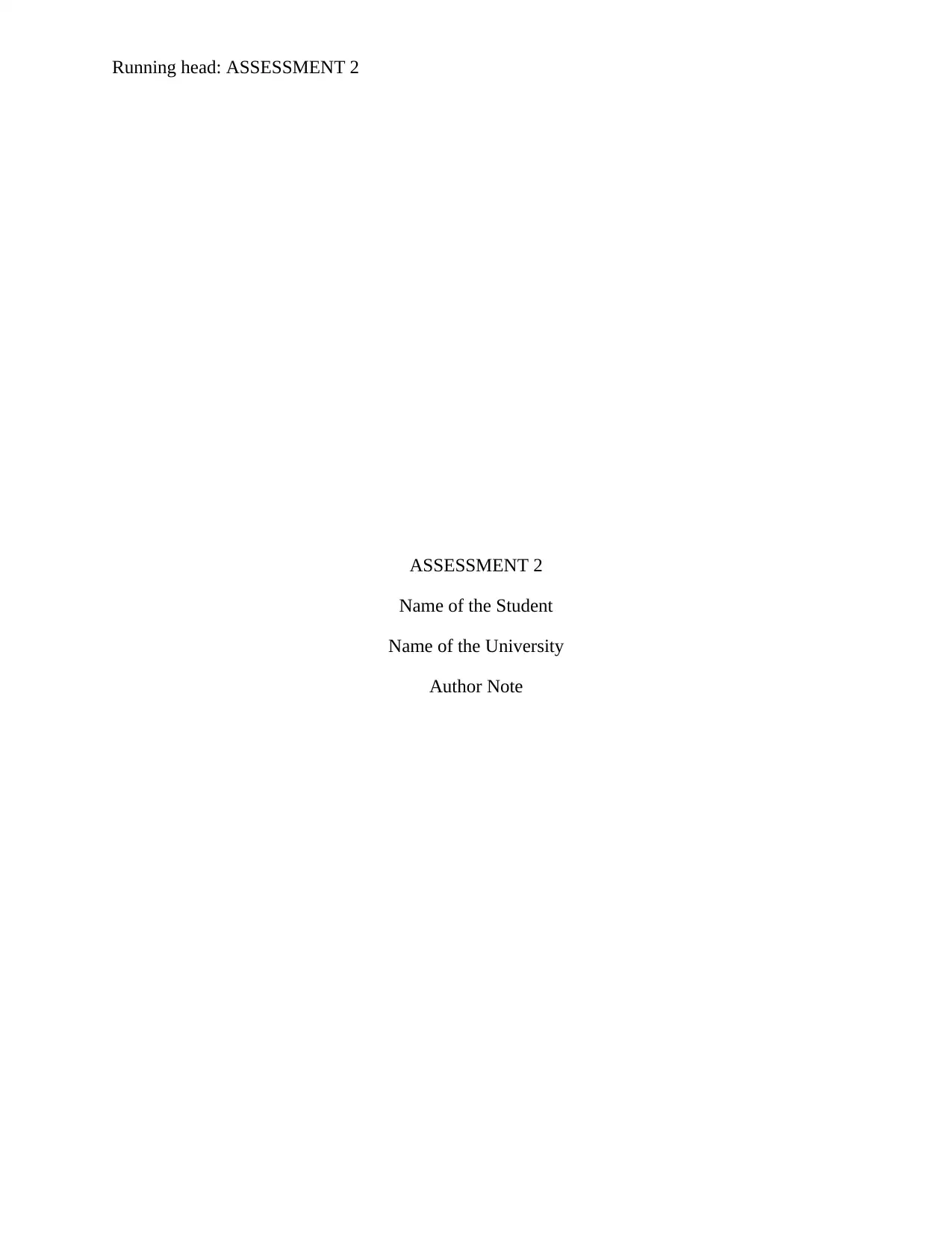
Running head: ASSESSMENT 2
ASSESSMENT 2
Name of the Student
Name of the University
Author Note
ASSESSMENT 2
Name of the Student
Name of the University
Author Note
Secure Best Marks with AI Grader
Need help grading? Try our AI Grader for instant feedback on your assignments.
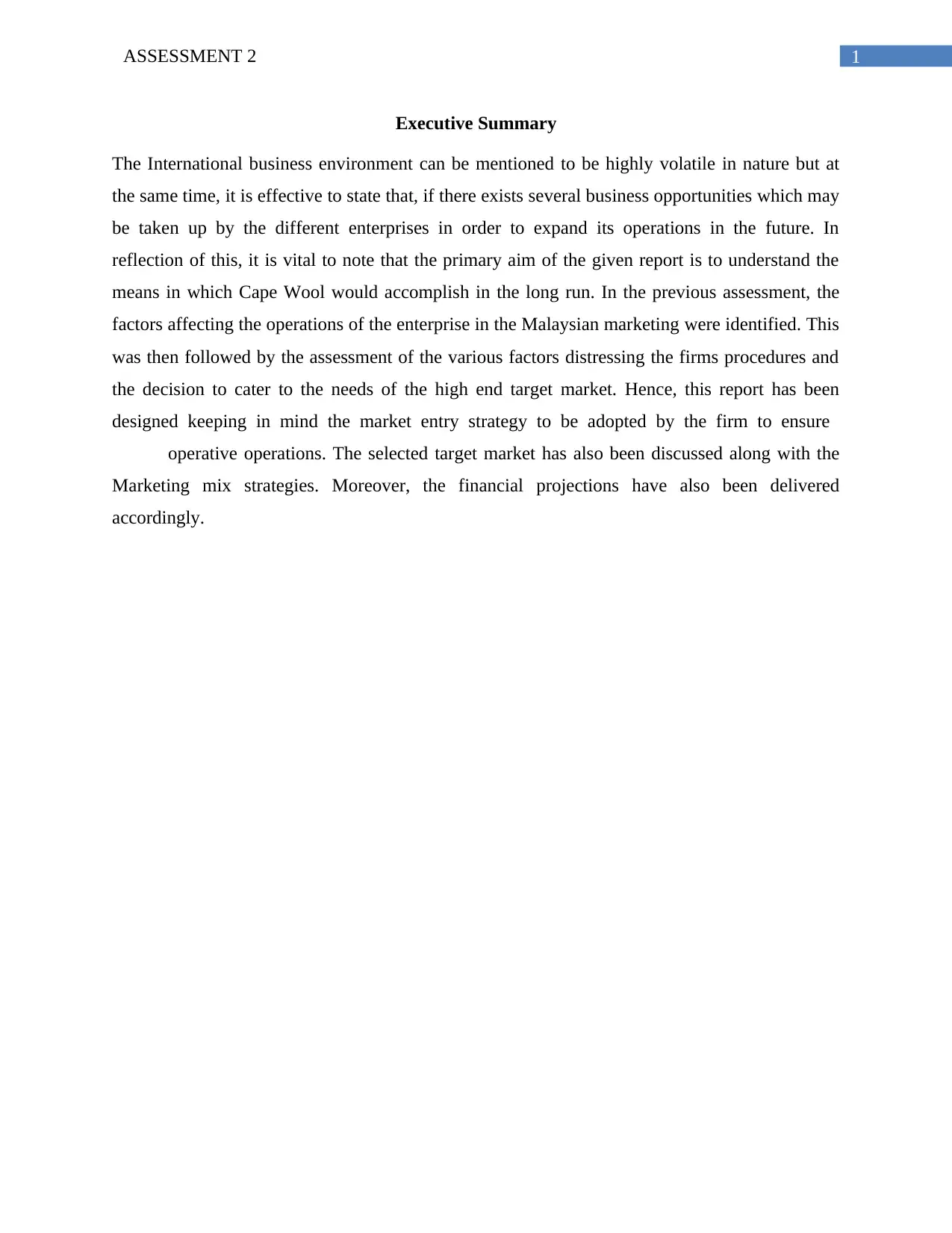
1ASSESSMENT 2
Executive Summary
The International business environment can be mentioned to be highly volatile in nature but at
the same time, it is effective to state that, if there exists several business opportunities which may
be taken up by the different enterprises in order to expand its operations in the future. In
reflection of this, it is vital to note that the primary aim of the given report is to understand the
means in which Cape Wool would accomplish in the long run. In the previous assessment, the
factors affecting the operations of the enterprise in the Malaysian marketing were identified. This
was then followed by the assessment of the various factors distressing the firms procedures and
the decision to cater to the needs of the high end target market. Hence, this report has been
designed keeping in mind the market entry strategy to be adopted by the firm to ensure
operative operations. The selected target market has also been discussed along with the
Marketing mix strategies. Moreover, the financial projections have also been delivered
accordingly.
Executive Summary
The International business environment can be mentioned to be highly volatile in nature but at
the same time, it is effective to state that, if there exists several business opportunities which may
be taken up by the different enterprises in order to expand its operations in the future. In
reflection of this, it is vital to note that the primary aim of the given report is to understand the
means in which Cape Wool would accomplish in the long run. In the previous assessment, the
factors affecting the operations of the enterprise in the Malaysian marketing were identified. This
was then followed by the assessment of the various factors distressing the firms procedures and
the decision to cater to the needs of the high end target market. Hence, this report has been
designed keeping in mind the market entry strategy to be adopted by the firm to ensure
operative operations. The selected target market has also been discussed along with the
Marketing mix strategies. Moreover, the financial projections have also been delivered
accordingly.
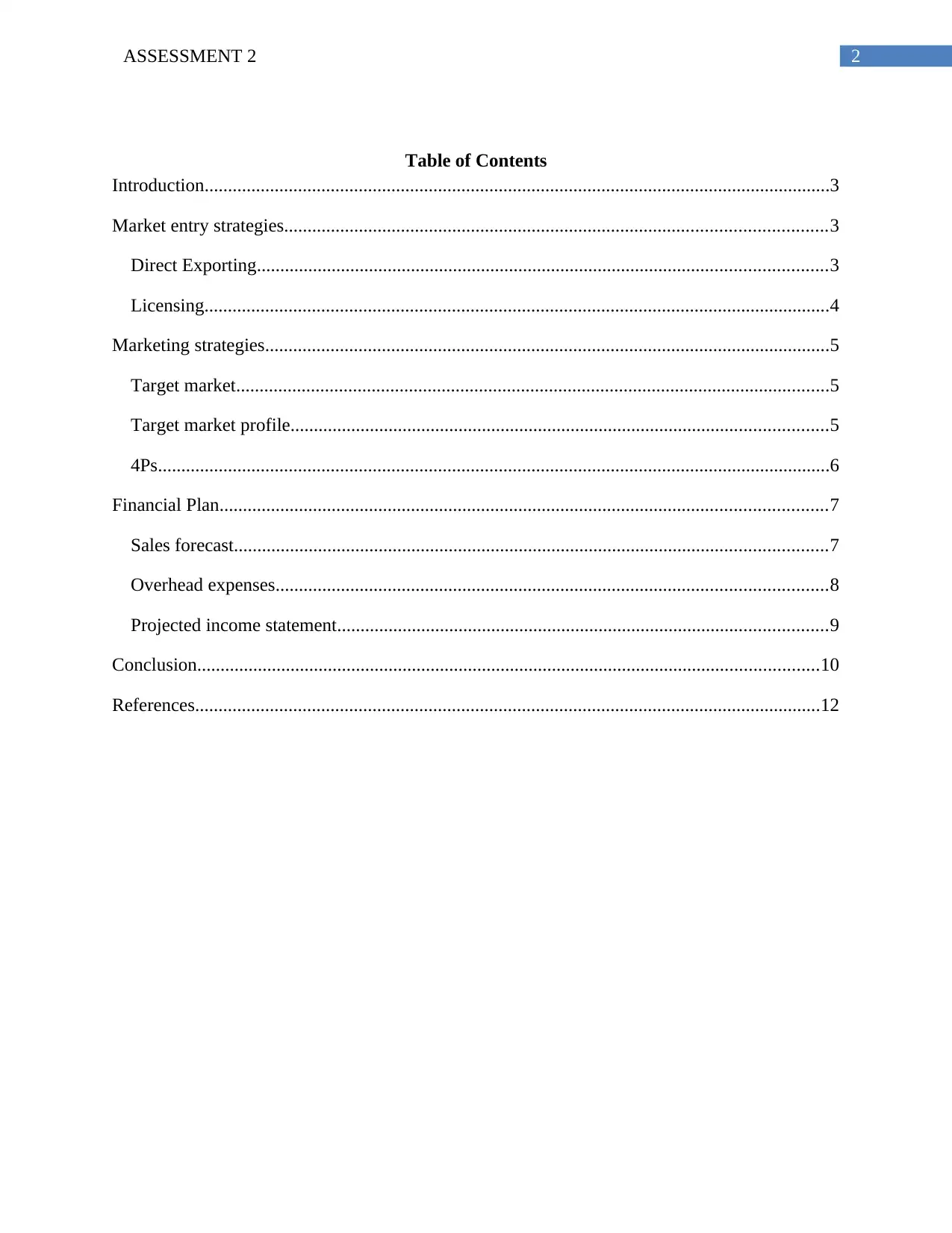
2ASSESSMENT 2
Table of Contents
Introduction......................................................................................................................................3
Market entry strategies....................................................................................................................3
Direct Exporting..........................................................................................................................3
Licensing......................................................................................................................................4
Marketing strategies.........................................................................................................................5
Target market...............................................................................................................................5
Target market profile...................................................................................................................5
4Ps................................................................................................................................................6
Financial Plan..................................................................................................................................7
Sales forecast...............................................................................................................................7
Overhead expenses......................................................................................................................8
Projected income statement.........................................................................................................9
Conclusion.....................................................................................................................................10
References......................................................................................................................................12
Table of Contents
Introduction......................................................................................................................................3
Market entry strategies....................................................................................................................3
Direct Exporting..........................................................................................................................3
Licensing......................................................................................................................................4
Marketing strategies.........................................................................................................................5
Target market...............................................................................................................................5
Target market profile...................................................................................................................5
4Ps................................................................................................................................................6
Financial Plan..................................................................................................................................7
Sales forecast...............................................................................................................................7
Overhead expenses......................................................................................................................8
Projected income statement.........................................................................................................9
Conclusion.....................................................................................................................................10
References......................................................................................................................................12
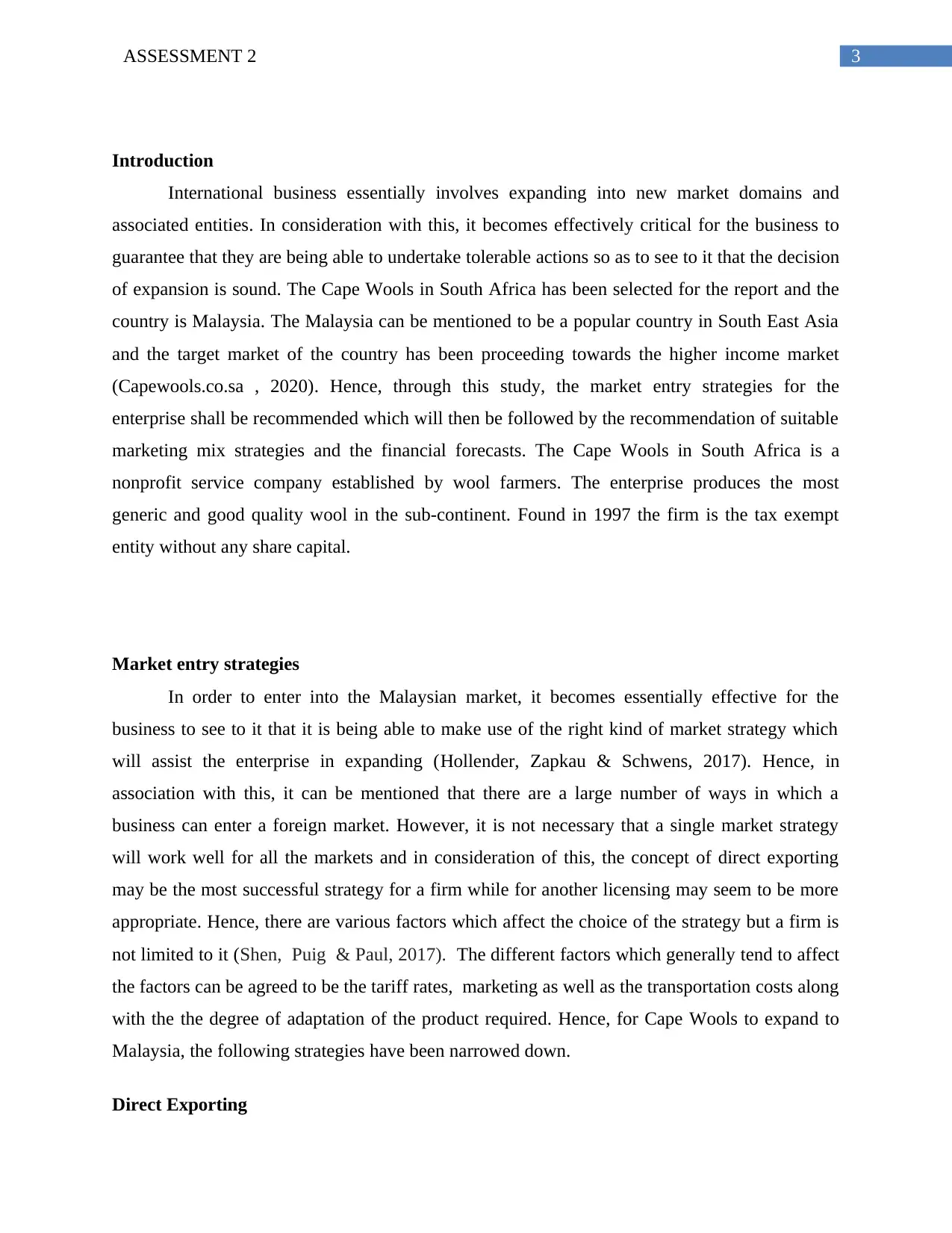
3ASSESSMENT 2
Introduction
International business essentially involves expanding into new market domains and
associated entities. In consideration with this, it becomes effectively critical for the business to
guarantee that they are being able to undertake tolerable actions so as to see to it that the decision
of expansion is sound. The Cape Wools in South Africa has been selected for the report and the
country is Malaysia. The Malaysia can be mentioned to be a popular country in South East Asia
and the target market of the country has been proceeding towards the higher income market
(Capewools.co.sa , 2020). Hence, through this study, the market entry strategies for the
enterprise shall be recommended which will then be followed by the recommendation of suitable
marketing mix strategies and the financial forecasts. The Cape Wools in South Africa is a
nonprofit service company established by wool farmers. The enterprise produces the most
generic and good quality wool in the sub-continent. Found in 1997 the firm is the tax exempt
entity without any share capital.
Market entry strategies
In order to enter into the Malaysian market, it becomes essentially effective for the
business to see to it that it is being able to make use of the right kind of market strategy which
will assist the enterprise in expanding (Hollender, Zapkau & Schwens, 2017). Hence, in
association with this, it can be mentioned that there are a large number of ways in which a
business can enter a foreign market. However, it is not necessary that a single market strategy
will work well for all the markets and in consideration of this, the concept of direct exporting
may be the most successful strategy for a firm while for another licensing may seem to be more
appropriate. Hence, there are various factors which affect the choice of the strategy but a firm is
not limited to it (Shen, Puig & Paul, 2017). The different factors which generally tend to affect
the factors can be agreed to be the tariff rates, marketing as well as the transportation costs along
with the the degree of adaptation of the product required. Hence, for Cape Wools to expand to
Malaysia, the following strategies have been narrowed down.
Direct Exporting
Introduction
International business essentially involves expanding into new market domains and
associated entities. In consideration with this, it becomes effectively critical for the business to
guarantee that they are being able to undertake tolerable actions so as to see to it that the decision
of expansion is sound. The Cape Wools in South Africa has been selected for the report and the
country is Malaysia. The Malaysia can be mentioned to be a popular country in South East Asia
and the target market of the country has been proceeding towards the higher income market
(Capewools.co.sa , 2020). Hence, through this study, the market entry strategies for the
enterprise shall be recommended which will then be followed by the recommendation of suitable
marketing mix strategies and the financial forecasts. The Cape Wools in South Africa is a
nonprofit service company established by wool farmers. The enterprise produces the most
generic and good quality wool in the sub-continent. Found in 1997 the firm is the tax exempt
entity without any share capital.
Market entry strategies
In order to enter into the Malaysian market, it becomes essentially effective for the
business to see to it that it is being able to make use of the right kind of market strategy which
will assist the enterprise in expanding (Hollender, Zapkau & Schwens, 2017). Hence, in
association with this, it can be mentioned that there are a large number of ways in which a
business can enter a foreign market. However, it is not necessary that a single market strategy
will work well for all the markets and in consideration of this, the concept of direct exporting
may be the most successful strategy for a firm while for another licensing may seem to be more
appropriate. Hence, there are various factors which affect the choice of the strategy but a firm is
not limited to it (Shen, Puig & Paul, 2017). The different factors which generally tend to affect
the factors can be agreed to be the tariff rates, marketing as well as the transportation costs along
with the the degree of adaptation of the product required. Hence, for Cape Wools to expand to
Malaysia, the following strategies have been narrowed down.
Direct Exporting
Secure Best Marks with AI Grader
Need help grading? Try our AI Grader for instant feedback on your assignments.
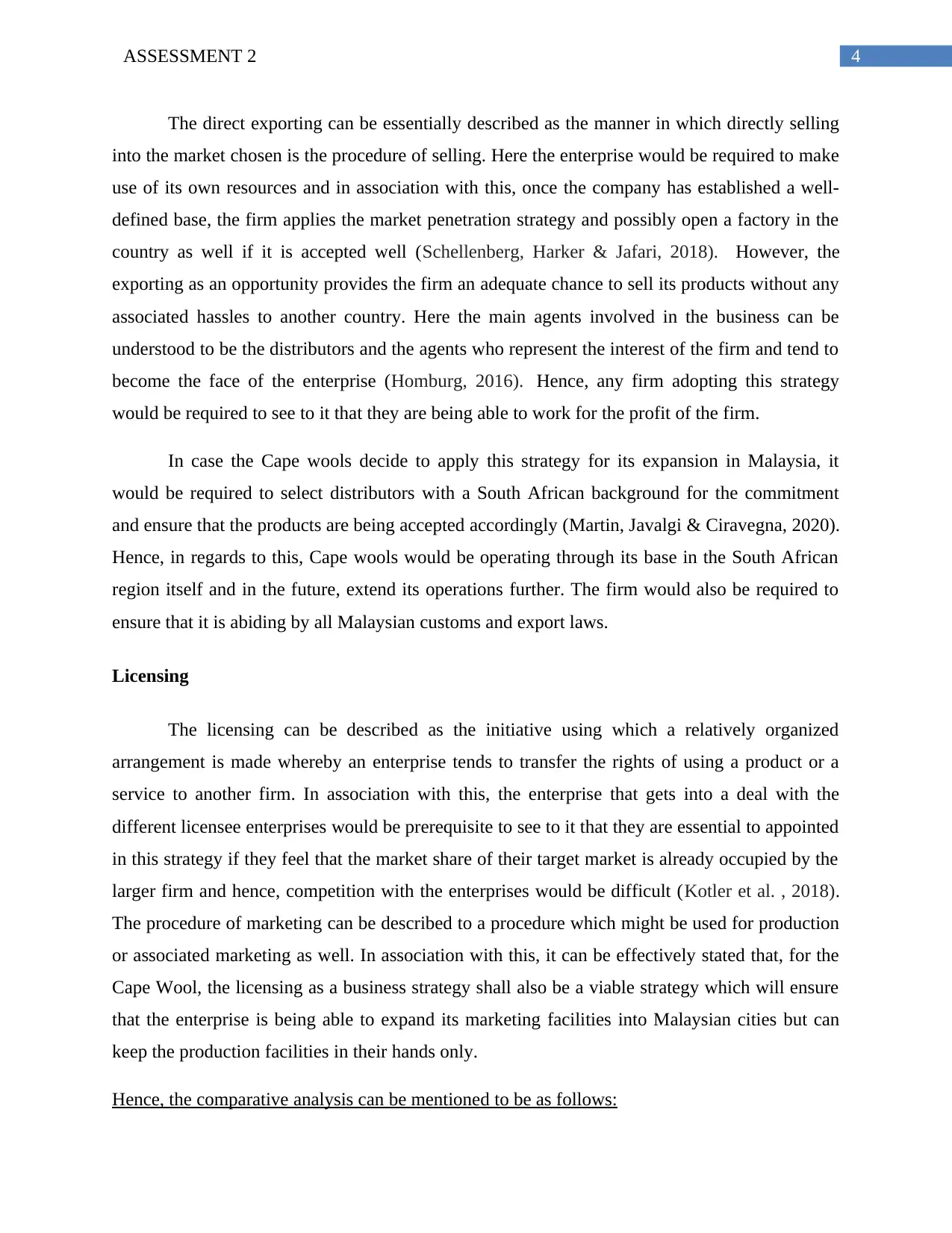
4ASSESSMENT 2
The direct exporting can be essentially described as the manner in which directly selling
into the market chosen is the procedure of selling. Here the enterprise would be required to make
use of its own resources and in association with this, once the company has established a well-
defined base, the firm applies the market penetration strategy and possibly open a factory in the
country as well if it is accepted well (Schellenberg, Harker & Jafari, 2018). However, the
exporting as an opportunity provides the firm an adequate chance to sell its products without any
associated hassles to another country. Here the main agents involved in the business can be
understood to be the distributors and the agents who represent the interest of the firm and tend to
become the face of the enterprise (Homburg, 2016). Hence, any firm adopting this strategy
would be required to see to it that they are being able to work for the profit of the firm.
In case the Cape wools decide to apply this strategy for its expansion in Malaysia, it
would be required to select distributors with a South African background for the commitment
and ensure that the products are being accepted accordingly (Martin, Javalgi & Ciravegna, 2020).
Hence, in regards to this, Cape wools would be operating through its base in the South African
region itself and in the future, extend its operations further. The firm would also be required to
ensure that it is abiding by all Malaysian customs and export laws.
Licensing
The licensing can be described as the initiative using which a relatively organized
arrangement is made whereby an enterprise tends to transfer the rights of using a product or a
service to another firm. In association with this, the enterprise that gets into a deal with the
different licensee enterprises would be prerequisite to see to it that they are essential to appointed
in this strategy if they feel that the market share of their target market is already occupied by the
larger firm and hence, competition with the enterprises would be difficult (Kotler et al. , 2018).
The procedure of marketing can be described to a procedure which might be used for production
or associated marketing as well. In association with this, it can be effectively stated that, for the
Cape Wool, the licensing as a business strategy shall also be a viable strategy which will ensure
that the enterprise is being able to expand its marketing facilities into Malaysian cities but can
keep the production facilities in their hands only.
Hence, the comparative analysis can be mentioned to be as follows:
The direct exporting can be essentially described as the manner in which directly selling
into the market chosen is the procedure of selling. Here the enterprise would be required to make
use of its own resources and in association with this, once the company has established a well-
defined base, the firm applies the market penetration strategy and possibly open a factory in the
country as well if it is accepted well (Schellenberg, Harker & Jafari, 2018). However, the
exporting as an opportunity provides the firm an adequate chance to sell its products without any
associated hassles to another country. Here the main agents involved in the business can be
understood to be the distributors and the agents who represent the interest of the firm and tend to
become the face of the enterprise (Homburg, 2016). Hence, any firm adopting this strategy
would be required to see to it that they are being able to work for the profit of the firm.
In case the Cape wools decide to apply this strategy for its expansion in Malaysia, it
would be required to select distributors with a South African background for the commitment
and ensure that the products are being accepted accordingly (Martin, Javalgi & Ciravegna, 2020).
Hence, in regards to this, Cape wools would be operating through its base in the South African
region itself and in the future, extend its operations further. The firm would also be required to
ensure that it is abiding by all Malaysian customs and export laws.
Licensing
The licensing can be described as the initiative using which a relatively organized
arrangement is made whereby an enterprise tends to transfer the rights of using a product or a
service to another firm. In association with this, the enterprise that gets into a deal with the
different licensee enterprises would be prerequisite to see to it that they are essential to appointed
in this strategy if they feel that the market share of their target market is already occupied by the
larger firm and hence, competition with the enterprises would be difficult (Kotler et al. , 2018).
The procedure of marketing can be described to a procedure which might be used for production
or associated marketing as well. In association with this, it can be effectively stated that, for the
Cape Wool, the licensing as a business strategy shall also be a viable strategy which will ensure
that the enterprise is being able to expand its marketing facilities into Malaysian cities but can
keep the production facilities in their hands only.
Hence, the comparative analysis can be mentioned to be as follows:
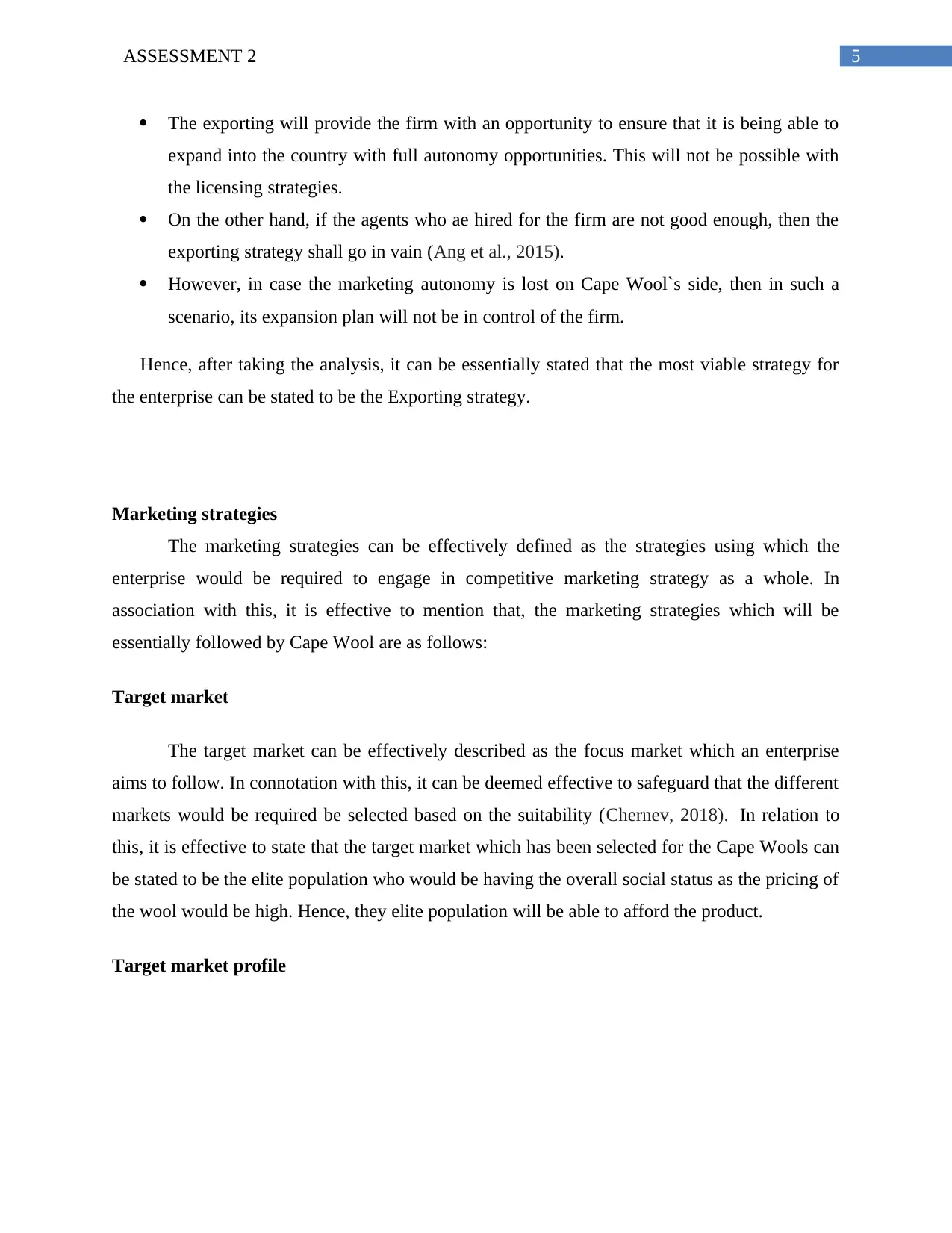
5ASSESSMENT 2
The exporting will provide the firm with an opportunity to ensure that it is being able to
expand into the country with full autonomy opportunities. This will not be possible with
the licensing strategies.
On the other hand, if the agents who ae hired for the firm are not good enough, then the
exporting strategy shall go in vain (Ang et al., 2015).
However, in case the marketing autonomy is lost on Cape Wool`s side, then in such a
scenario, its expansion plan will not be in control of the firm.
Hence, after taking the analysis, it can be essentially stated that the most viable strategy for
the enterprise can be stated to be the Exporting strategy.
Marketing strategies
The marketing strategies can be effectively defined as the strategies using which the
enterprise would be required to engage in competitive marketing strategy as a whole. In
association with this, it is effective to mention that, the marketing strategies which will be
essentially followed by Cape Wool are as follows:
Target market
The target market can be effectively described as the focus market which an enterprise
aims to follow. In connotation with this, it can be deemed effective to safeguard that the different
markets would be required be selected based on the suitability (Chernev, 2018). In relation to
this, it is effective to state that the target market which has been selected for the Cape Wools can
be stated to be the elite population who would be having the overall social status as the pricing of
the wool would be high. Hence, they elite population will be able to afford the product.
Target market profile
The exporting will provide the firm with an opportunity to ensure that it is being able to
expand into the country with full autonomy opportunities. This will not be possible with
the licensing strategies.
On the other hand, if the agents who ae hired for the firm are not good enough, then the
exporting strategy shall go in vain (Ang et al., 2015).
However, in case the marketing autonomy is lost on Cape Wool`s side, then in such a
scenario, its expansion plan will not be in control of the firm.
Hence, after taking the analysis, it can be essentially stated that the most viable strategy for
the enterprise can be stated to be the Exporting strategy.
Marketing strategies
The marketing strategies can be effectively defined as the strategies using which the
enterprise would be required to engage in competitive marketing strategy as a whole. In
association with this, it is effective to mention that, the marketing strategies which will be
essentially followed by Cape Wool are as follows:
Target market
The target market can be effectively described as the focus market which an enterprise
aims to follow. In connotation with this, it can be deemed effective to safeguard that the different
markets would be required be selected based on the suitability (Chernev, 2018). In relation to
this, it is effective to state that the target market which has been selected for the Cape Wools can
be stated to be the elite population who would be having the overall social status as the pricing of
the wool would be high. Hence, they elite population will be able to afford the product.
Target market profile
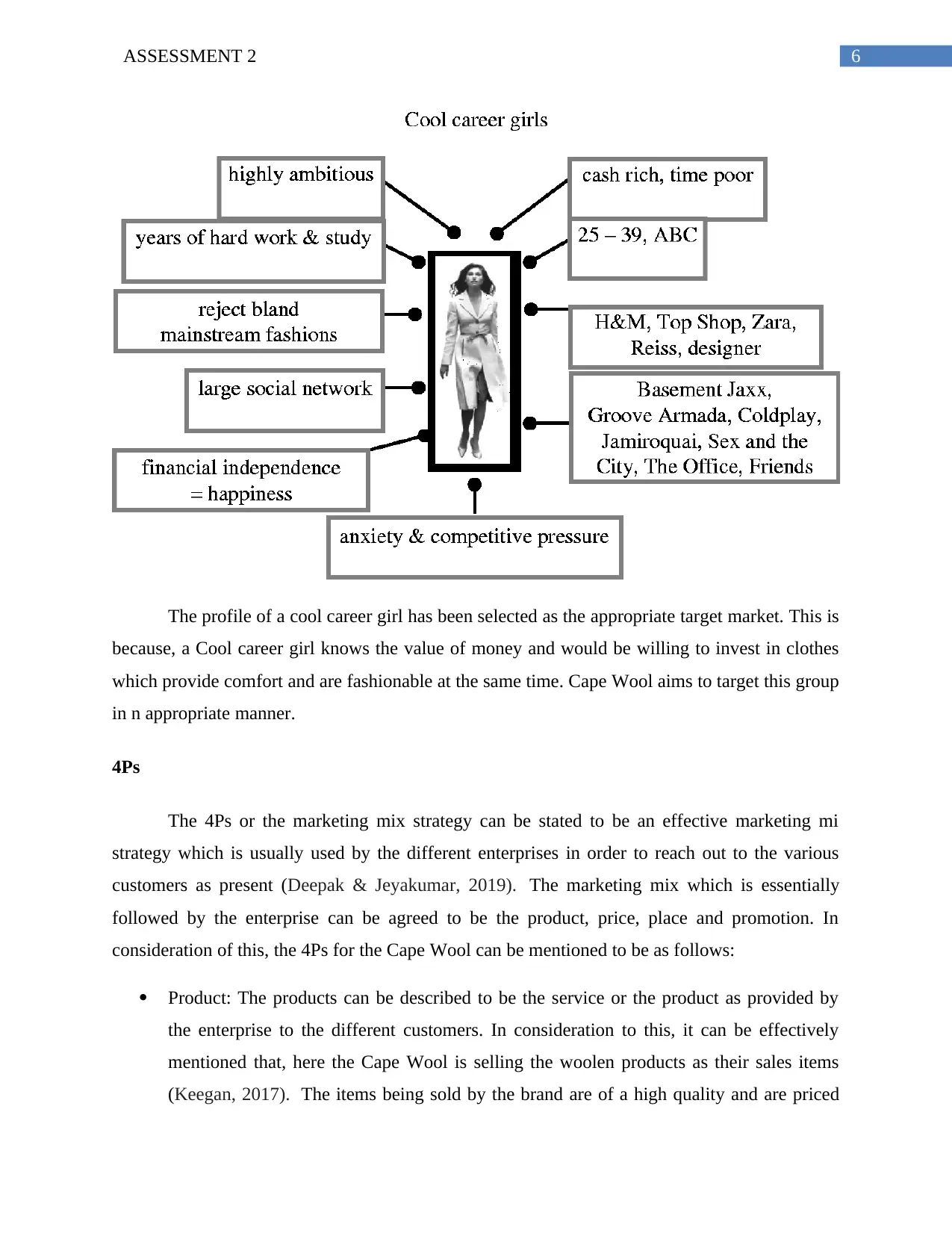
6ASSESSMENT 2
The profile of a cool career girl has been selected as the appropriate target market. This is
because, a Cool career girl knows the value of money and would be willing to invest in clothes
which provide comfort and are fashionable at the same time. Cape Wool aims to target this group
in n appropriate manner.
4Ps
The 4Ps or the marketing mix strategy can be stated to be an effective marketing mi
strategy which is usually used by the different enterprises in order to reach out to the various
customers as present (Deepak & Jeyakumar, 2019). The marketing mix which is essentially
followed by the enterprise can be agreed to be the product, price, place and promotion. In
consideration of this, the 4Ps for the Cape Wool can be mentioned to be as follows:
Product: The products can be described to be the service or the product as provided by
the enterprise to the different customers. In consideration to this, it can be effectively
mentioned that, here the Cape Wool is selling the woolen products as their sales items
(Keegan, 2017). The items being sold by the brand are of a high quality and are priced
The profile of a cool career girl has been selected as the appropriate target market. This is
because, a Cool career girl knows the value of money and would be willing to invest in clothes
which provide comfort and are fashionable at the same time. Cape Wool aims to target this group
in n appropriate manner.
4Ps
The 4Ps or the marketing mix strategy can be stated to be an effective marketing mi
strategy which is usually used by the different enterprises in order to reach out to the various
customers as present (Deepak & Jeyakumar, 2019). The marketing mix which is essentially
followed by the enterprise can be agreed to be the product, price, place and promotion. In
consideration of this, the 4Ps for the Cape Wool can be mentioned to be as follows:
Product: The products can be described to be the service or the product as provided by
the enterprise to the different customers. In consideration to this, it can be effectively
mentioned that, here the Cape Wool is selling the woolen products as their sales items
(Keegan, 2017). The items being sold by the brand are of a high quality and are priced
Paraphrase This Document
Need a fresh take? Get an instant paraphrase of this document with our AI Paraphraser

7ASSESSMENT 2
high as well, aiming at the elite class (Eastman et al., 2015). These items sold by Cape
Wool come in various designs and colors. It is durable and fulfills the needs of the
customers.
Price: The price can be described as the pricing strategy which is implemented by the
firm. In case of the Cape Wool, the pricing strategy which is followed by the firm is the
Price Skimming strategy. In consideration of this, it can be effectively stated that the
Price skimming strategy as followed by the enterprise will set the brand name of the
enterprise as an elite brand and will help in a better reach (Kerr & Patti, 2015). These
costs will be placed keeping in mind the export and transportation costs of the firms. By
maintaining this pricing strategy, the firm will be able to ensure that all its operations can
be attained successfully.
Place: The place strategy ca is stated to be the distribution strategy which is generally
followed by an enterprise (Fraccastoro & Gabrielsson, 2018). In consideration with this,
it can be understood that as the company has selected the exporting strategy as the
distribution strategy, it is up to the agents to decide the manner in which they would like
to distribute the products accordingly (Hannibal, Evers & Servais, 2016). In line with
this, it is effective to state that the product might be distributed through instore sales or
the online e-commerce strategy.
Promotion: The promotion strategy can be declared to be the overall marketing strategy
which is generally followed by the enterprise. With this, there are a number of promotion
mix aspects which can be followed by the Cape Wool are online and digital marketing
strategy, social media marketing strategy, the print media strategy, the associated
television marketing and other associated strategies which can be followed by the
enterprise to market the products accordingly (Haider et al., 2017).
Financial Plan
Sales forecast
high as well, aiming at the elite class (Eastman et al., 2015). These items sold by Cape
Wool come in various designs and colors. It is durable and fulfills the needs of the
customers.
Price: The price can be described as the pricing strategy which is implemented by the
firm. In case of the Cape Wool, the pricing strategy which is followed by the firm is the
Price Skimming strategy. In consideration of this, it can be effectively stated that the
Price skimming strategy as followed by the enterprise will set the brand name of the
enterprise as an elite brand and will help in a better reach (Kerr & Patti, 2015). These
costs will be placed keeping in mind the export and transportation costs of the firms. By
maintaining this pricing strategy, the firm will be able to ensure that all its operations can
be attained successfully.
Place: The place strategy ca is stated to be the distribution strategy which is generally
followed by an enterprise (Fraccastoro & Gabrielsson, 2018). In consideration with this,
it can be understood that as the company has selected the exporting strategy as the
distribution strategy, it is up to the agents to decide the manner in which they would like
to distribute the products accordingly (Hannibal, Evers & Servais, 2016). In line with
this, it is effective to state that the product might be distributed through instore sales or
the online e-commerce strategy.
Promotion: The promotion strategy can be declared to be the overall marketing strategy
which is generally followed by the enterprise. With this, there are a number of promotion
mix aspects which can be followed by the Cape Wool are online and digital marketing
strategy, social media marketing strategy, the print media strategy, the associated
television marketing and other associated strategies which can be followed by the
enterprise to market the products accordingly (Haider et al., 2017).
Financial Plan
Sales forecast
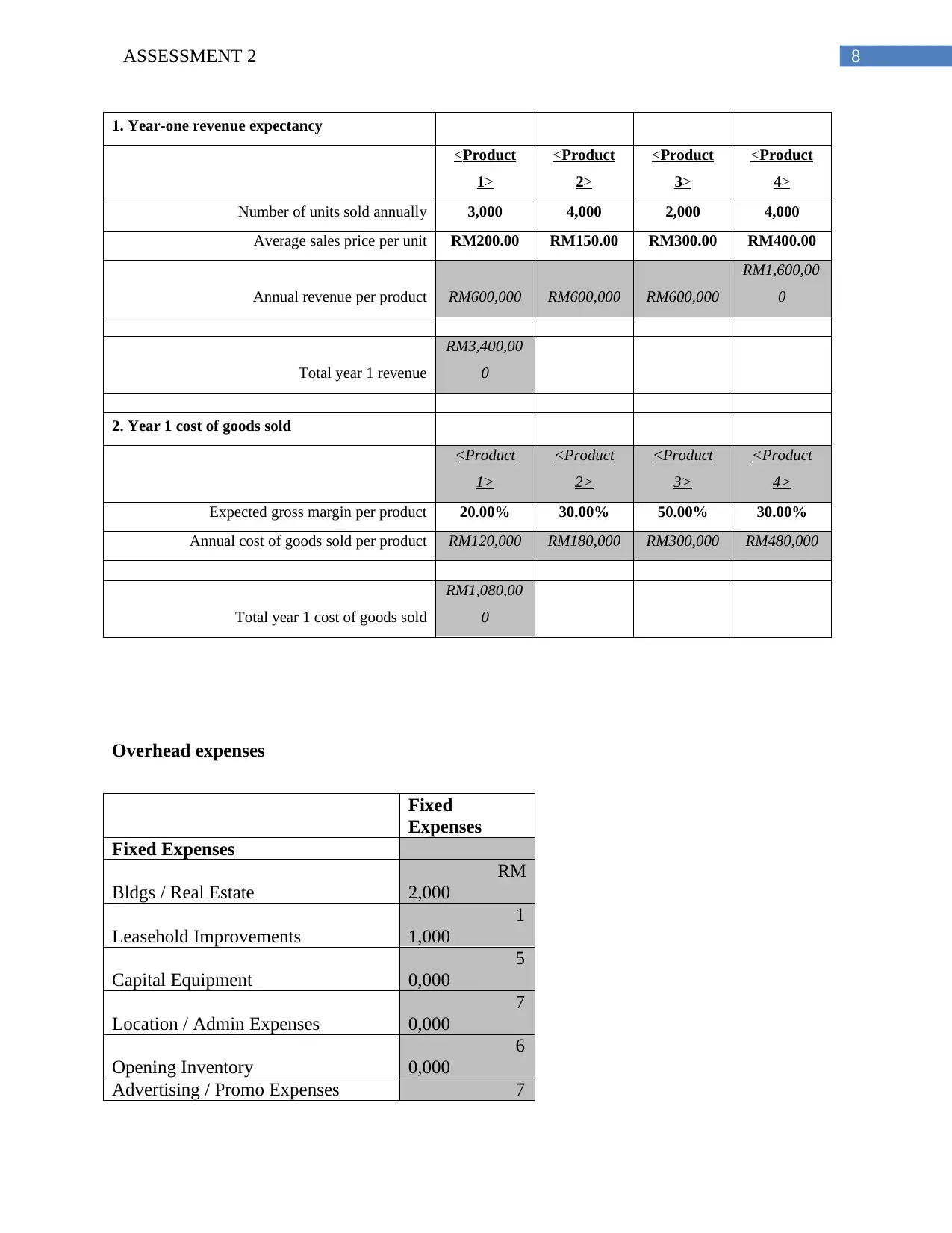
8ASSESSMENT 2
1. Year-one revenue expectancy
<Product
1>
<Product
2>
<Product
3>
<Product
4>
Number of units sold annually 3,000 4,000 2,000 4,000
Average sales price per unit RM200.00 RM150.00 RM300.00 RM400.00
Annual revenue per product RM600,000 RM600,000 RM600,000
RM1,600,00
0
Total year 1 revenue
RM3,400,00
0
2. Year 1 cost of goods sold
<Product
1>
<Product
2>
<Product
3>
<Product
4>
Expected gross margin per product 20.00% 30.00% 50.00% 30.00%
Annual cost of goods sold per product RM120,000 RM180,000 RM300,000 RM480,000
Total year 1 cost of goods sold
RM1,080,00
0
Overhead expenses
Fixed
Expenses
Fixed Expenses
Bldgs / Real Estate
RM
2,000
Leasehold Improvements
1
1,000
Capital Equipment
5
0,000
Location / Admin Expenses
7
0,000
Opening Inventory
6
0,000
Advertising / Promo Expenses 7
1. Year-one revenue expectancy
<Product
1>
<Product
2>
<Product
3>
<Product
4>
Number of units sold annually 3,000 4,000 2,000 4,000
Average sales price per unit RM200.00 RM150.00 RM300.00 RM400.00
Annual revenue per product RM600,000 RM600,000 RM600,000
RM1,600,00
0
Total year 1 revenue
RM3,400,00
0
2. Year 1 cost of goods sold
<Product
1>
<Product
2>
<Product
3>
<Product
4>
Expected gross margin per product 20.00% 30.00% 50.00% 30.00%
Annual cost of goods sold per product RM120,000 RM180,000 RM300,000 RM480,000
Total year 1 cost of goods sold
RM1,080,00
0
Overhead expenses
Fixed
Expenses
Fixed Expenses
Bldgs / Real Estate
RM
2,000
Leasehold Improvements
1
1,000
Capital Equipment
5
0,000
Location / Admin Expenses
7
0,000
Opening Inventory
6
0,000
Advertising / Promo Expenses 7
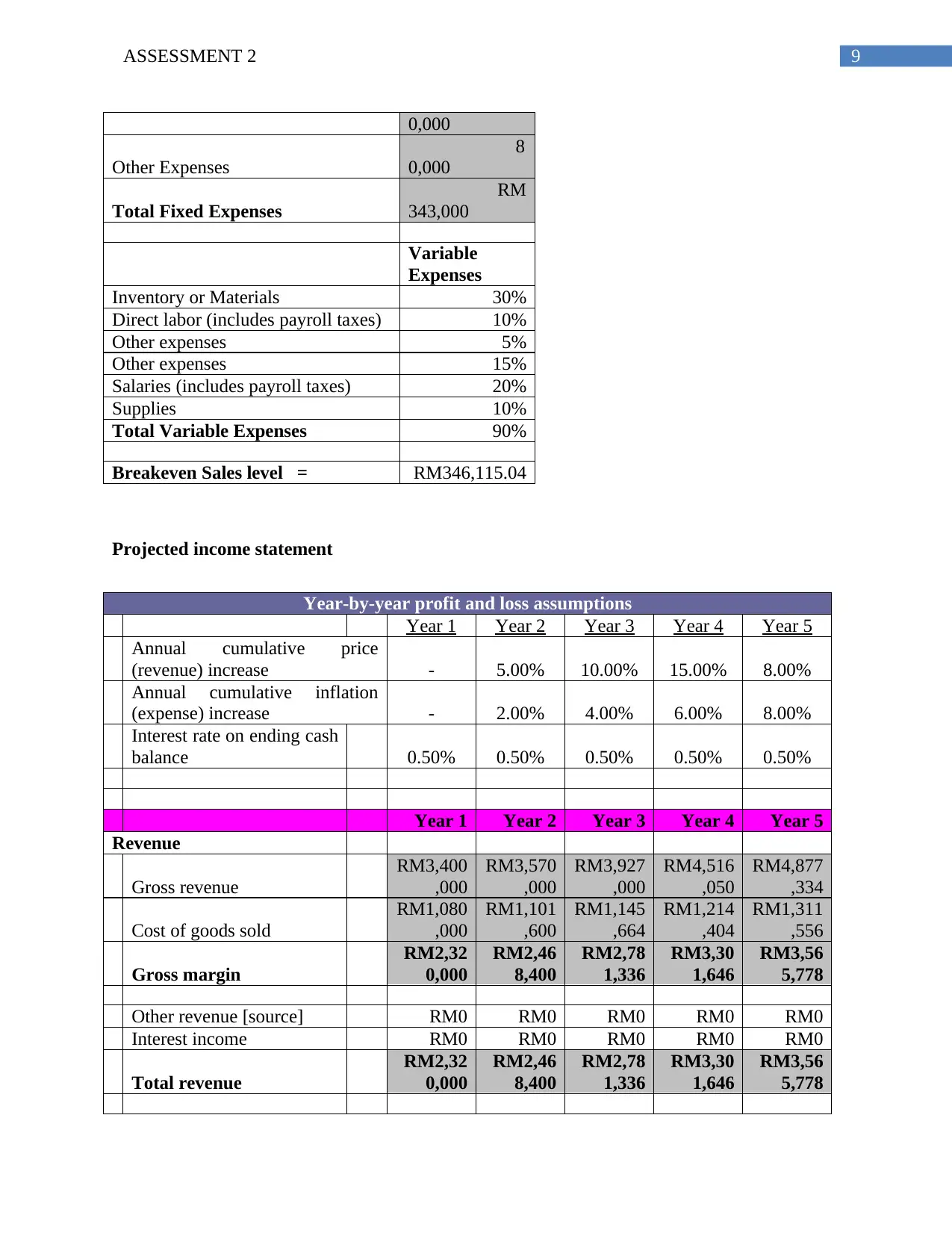
9ASSESSMENT 2
0,000
Other Expenses
8
0,000
Total Fixed Expenses
RM
343,000
Variable
Expenses
Inventory or Materials 30%
Direct labor (includes payroll taxes) 10%
Other expenses 5%
Other expenses 15%
Salaries (includes payroll taxes) 20%
Supplies 10%
Total Variable Expenses 90%
Breakeven Sales level = RM346,115.04
Projected income statement
Year-by-year profit and loss assumptions
Year 1 Year 2 Year 3 Year 4 Year 5
Annual cumulative price
(revenue) increase - 5.00% 10.00% 15.00% 8.00%
Annual cumulative inflation
(expense) increase - 2.00% 4.00% 6.00% 8.00%
Interest rate on ending cash
balance 0.50% 0.50% 0.50% 0.50% 0.50%
Year 1 Year 2 Year 3 Year 4 Year 5
Revenue
Gross revenue
RM3,400
,000
RM3,570
,000
RM3,927
,000
RM4,516
,050
RM4,877
,334
Cost of goods sold
RM1,080
,000
RM1,101
,600
RM1,145
,664
RM1,214
,404
RM1,311
,556
Gross margin
RM2,32
0,000
RM2,46
8,400
RM2,78
1,336
RM3,30
1,646
RM3,56
5,778
Other revenue [source] RM0 RM0 RM0 RM0 RM0
Interest income RM0 RM0 RM0 RM0 RM0
Total revenue
RM2,32
0,000
RM2,46
8,400
RM2,78
1,336
RM3,30
1,646
RM3,56
5,778
0,000
Other Expenses
8
0,000
Total Fixed Expenses
RM
343,000
Variable
Expenses
Inventory or Materials 30%
Direct labor (includes payroll taxes) 10%
Other expenses 5%
Other expenses 15%
Salaries (includes payroll taxes) 20%
Supplies 10%
Total Variable Expenses 90%
Breakeven Sales level = RM346,115.04
Projected income statement
Year-by-year profit and loss assumptions
Year 1 Year 2 Year 3 Year 4 Year 5
Annual cumulative price
(revenue) increase - 5.00% 10.00% 15.00% 8.00%
Annual cumulative inflation
(expense) increase - 2.00% 4.00% 6.00% 8.00%
Interest rate on ending cash
balance 0.50% 0.50% 0.50% 0.50% 0.50%
Year 1 Year 2 Year 3 Year 4 Year 5
Revenue
Gross revenue
RM3,400
,000
RM3,570
,000
RM3,927
,000
RM4,516
,050
RM4,877
,334
Cost of goods sold
RM1,080
,000
RM1,101
,600
RM1,145
,664
RM1,214
,404
RM1,311
,556
Gross margin
RM2,32
0,000
RM2,46
8,400
RM2,78
1,336
RM3,30
1,646
RM3,56
5,778
Other revenue [source] RM0 RM0 RM0 RM0 RM0
Interest income RM0 RM0 RM0 RM0 RM0
Total revenue
RM2,32
0,000
RM2,46
8,400
RM2,78
1,336
RM3,30
1,646
RM3,56
5,778
Secure Best Marks with AI Grader
Need help grading? Try our AI Grader for instant feedback on your assignments.
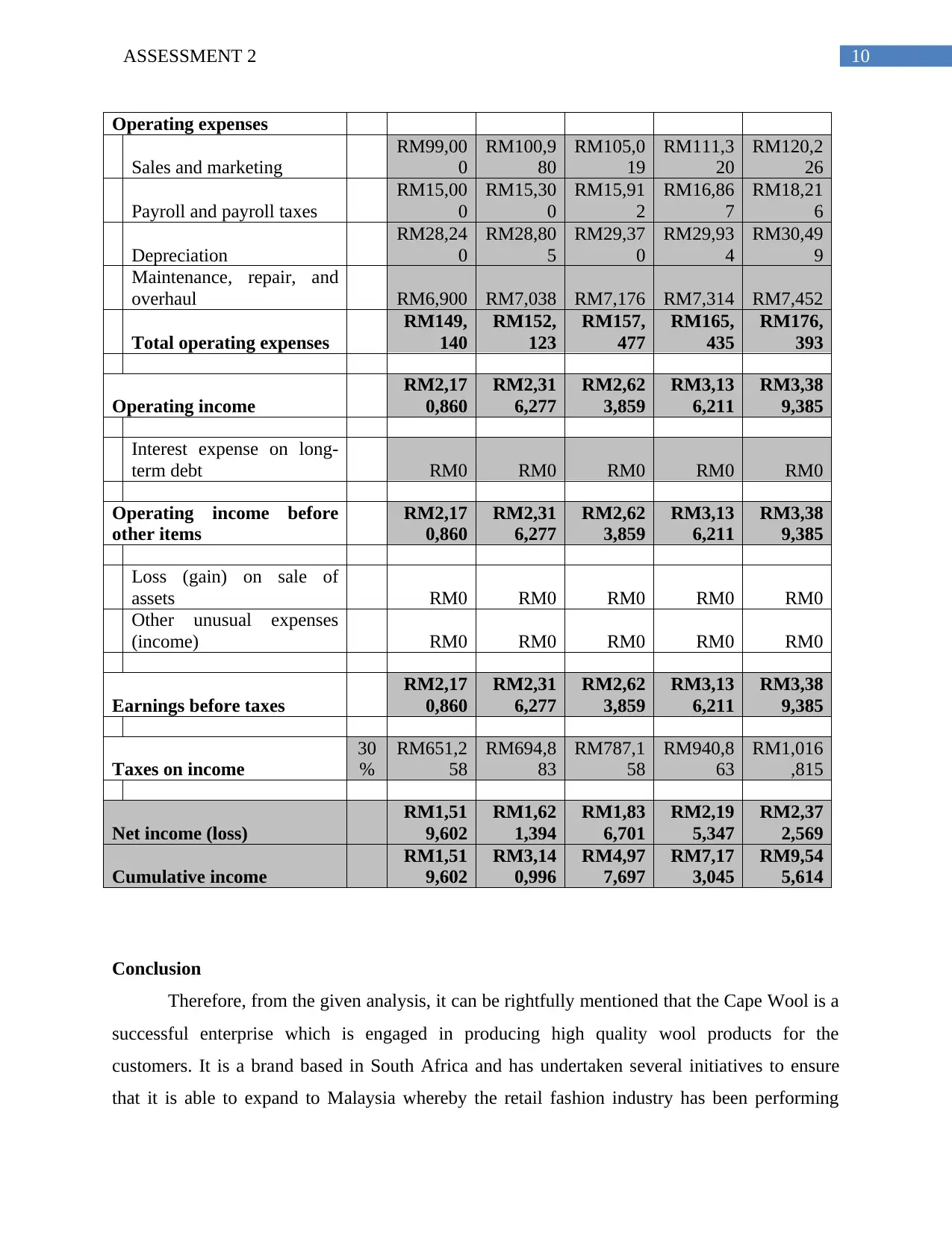
10ASSESSMENT 2
Operating expenses
Sales and marketing
RM99,00
0
RM100,9
80
RM105,0
19
RM111,3
20
RM120,2
26
Payroll and payroll taxes
RM15,00
0
RM15,30
0
RM15,91
2
RM16,86
7
RM18,21
6
Depreciation
RM28,24
0
RM28,80
5
RM29,37
0
RM29,93
4
RM30,49
9
Maintenance, repair, and
overhaul RM6,900 RM7,038 RM7,176 RM7,314 RM7,452
Total operating expenses
RM149,
140
RM152,
123
RM157,
477
RM165,
435
RM176,
393
Operating income
RM2,17
0,860
RM2,31
6,277
RM2,62
3,859
RM3,13
6,211
RM3,38
9,385
Interest expense on long-
term debt RM0 RM0 RM0 RM0 RM0
Operating income before
other items
RM2,17
0,860
RM2,31
6,277
RM2,62
3,859
RM3,13
6,211
RM3,38
9,385
Loss (gain) on sale of
assets RM0 RM0 RM0 RM0 RM0
Other unusual expenses
(income) RM0 RM0 RM0 RM0 RM0
Earnings before taxes
RM2,17
0,860
RM2,31
6,277
RM2,62
3,859
RM3,13
6,211
RM3,38
9,385
Taxes on income
30
%
RM651,2
58
RM694,8
83
RM787,1
58
RM940,8
63
RM1,016
,815
Net income (loss)
RM1,51
9,602
RM1,62
1,394
RM1,83
6,701
RM2,19
5,347
RM2,37
2,569
Cumulative income
RM1,51
9,602
RM3,14
0,996
RM4,97
7,697
RM7,17
3,045
RM9,54
5,614
Conclusion
Therefore, from the given analysis, it can be rightfully mentioned that the Cape Wool is a
successful enterprise which is engaged in producing high quality wool products for the
customers. It is a brand based in South Africa and has undertaken several initiatives to ensure
that it is able to expand to Malaysia whereby the retail fashion industry has been performing
Operating expenses
Sales and marketing
RM99,00
0
RM100,9
80
RM105,0
19
RM111,3
20
RM120,2
26
Payroll and payroll taxes
RM15,00
0
RM15,30
0
RM15,91
2
RM16,86
7
RM18,21
6
Depreciation
RM28,24
0
RM28,80
5
RM29,37
0
RM29,93
4
RM30,49
9
Maintenance, repair, and
overhaul RM6,900 RM7,038 RM7,176 RM7,314 RM7,452
Total operating expenses
RM149,
140
RM152,
123
RM157,
477
RM165,
435
RM176,
393
Operating income
RM2,17
0,860
RM2,31
6,277
RM2,62
3,859
RM3,13
6,211
RM3,38
9,385
Interest expense on long-
term debt RM0 RM0 RM0 RM0 RM0
Operating income before
other items
RM2,17
0,860
RM2,31
6,277
RM2,62
3,859
RM3,13
6,211
RM3,38
9,385
Loss (gain) on sale of
assets RM0 RM0 RM0 RM0 RM0
Other unusual expenses
(income) RM0 RM0 RM0 RM0 RM0
Earnings before taxes
RM2,17
0,860
RM2,31
6,277
RM2,62
3,859
RM3,13
6,211
RM3,38
9,385
Taxes on income
30
%
RM651,2
58
RM694,8
83
RM787,1
58
RM940,8
63
RM1,016
,815
Net income (loss)
RM1,51
9,602
RM1,62
1,394
RM1,83
6,701
RM2,19
5,347
RM2,37
2,569
Cumulative income
RM1,51
9,602
RM3,14
0,996
RM4,97
7,697
RM7,17
3,045
RM9,54
5,614
Conclusion
Therefore, from the given analysis, it can be rightfully mentioned that the Cape Wool is a
successful enterprise which is engaged in producing high quality wool products for the
customers. It is a brand based in South Africa and has undertaken several initiatives to ensure
that it is able to expand to Malaysia whereby the retail fashion industry has been performing
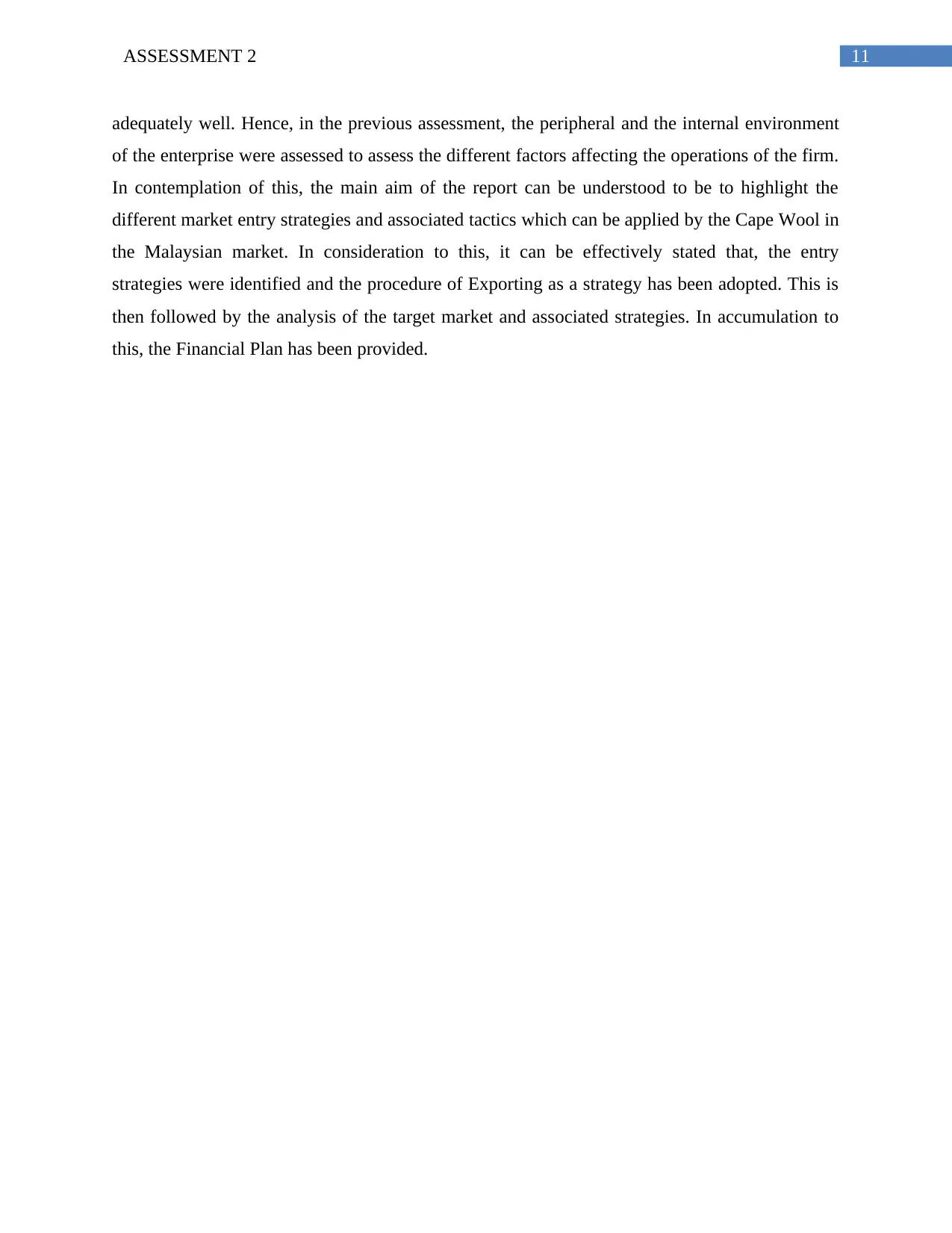
11ASSESSMENT 2
adequately well. Hence, in the previous assessment, the peripheral and the internal environment
of the enterprise were assessed to assess the different factors affecting the operations of the firm.
In contemplation of this, the main aim of the report can be understood to be to highlight the
different market entry strategies and associated tactics which can be applied by the Cape Wool in
the Malaysian market. In consideration to this, it can be effectively stated that, the entry
strategies were identified and the procedure of Exporting as a strategy has been adopted. This is
then followed by the analysis of the target market and associated strategies. In accumulation to
this, the Financial Plan has been provided.
adequately well. Hence, in the previous assessment, the peripheral and the internal environment
of the enterprise were assessed to assess the different factors affecting the operations of the firm.
In contemplation of this, the main aim of the report can be understood to be to highlight the
different market entry strategies and associated tactics which can be applied by the Cape Wool in
the Malaysian market. In consideration to this, it can be effectively stated that, the entry
strategies were identified and the procedure of Exporting as a strategy has been adopted. This is
then followed by the analysis of the target market and associated strategies. In accumulation to
this, the Financial Plan has been provided.
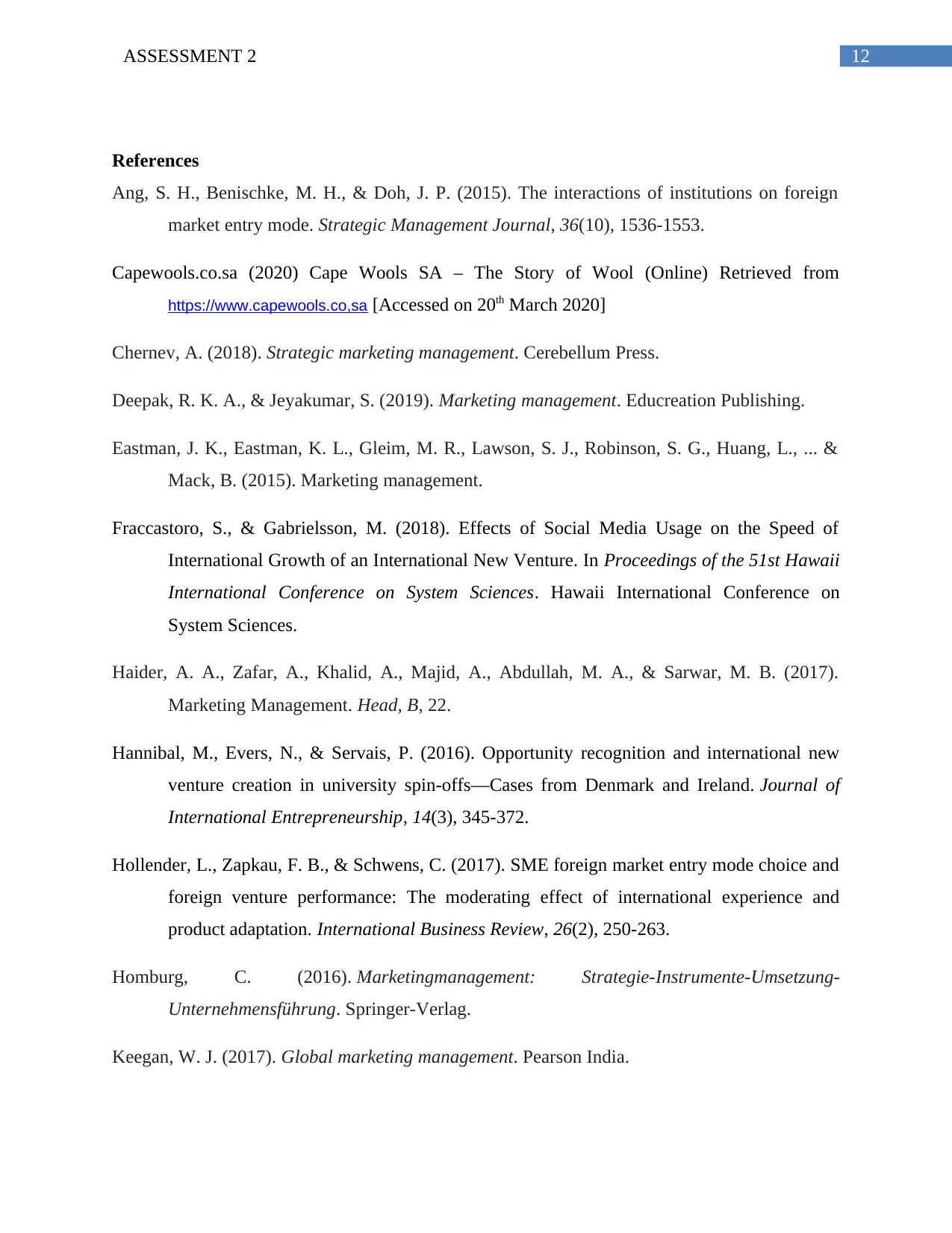
12ASSESSMENT 2
References
Ang, S. H., Benischke, M. H., & Doh, J. P. (2015). The interactions of institutions on foreign
market entry mode. Strategic Management Journal, 36(10), 1536-1553.
Capewools.co.sa (2020) Cape Wools SA – The Story of Wool (Online) Retrieved from
https://www.capewools.co,sa [Accessed on 20th March 2020]
Chernev, A. (2018). Strategic marketing management. Cerebellum Press.
Deepak, R. K. A., & Jeyakumar, S. (2019). Marketing management. Educreation Publishing.
Eastman, J. K., Eastman, K. L., Gleim, M. R., Lawson, S. J., Robinson, S. G., Huang, L., ... &
Mack, B. (2015). Marketing management.
Fraccastoro, S., & Gabrielsson, M. (2018). Effects of Social Media Usage on the Speed of
International Growth of an International New Venture. In Proceedings of the 51st Hawaii
International Conference on System Sciences. Hawaii International Conference on
System Sciences.
Haider, A. A., Zafar, A., Khalid, A., Majid, A., Abdullah, M. A., & Sarwar, M. B. (2017).
Marketing Management. Head, B, 22.
Hannibal, M., Evers, N., & Servais, P. (2016). Opportunity recognition and international new
venture creation in university spin-offs—Cases from Denmark and Ireland. Journal of
International Entrepreneurship, 14(3), 345-372.
Hollender, L., Zapkau, F. B., & Schwens, C. (2017). SME foreign market entry mode choice and
foreign venture performance: The moderating effect of international experience and
product adaptation. International Business Review, 26(2), 250-263.
Homburg, C. (2016). Marketingmanagement: Strategie-Instrumente-Umsetzung-
Unternehmensführung. Springer-Verlag.
Keegan, W. J. (2017). Global marketing management. Pearson India.
References
Ang, S. H., Benischke, M. H., & Doh, J. P. (2015). The interactions of institutions on foreign
market entry mode. Strategic Management Journal, 36(10), 1536-1553.
Capewools.co.sa (2020) Cape Wools SA – The Story of Wool (Online) Retrieved from
https://www.capewools.co,sa [Accessed on 20th March 2020]
Chernev, A. (2018). Strategic marketing management. Cerebellum Press.
Deepak, R. K. A., & Jeyakumar, S. (2019). Marketing management. Educreation Publishing.
Eastman, J. K., Eastman, K. L., Gleim, M. R., Lawson, S. J., Robinson, S. G., Huang, L., ... &
Mack, B. (2015). Marketing management.
Fraccastoro, S., & Gabrielsson, M. (2018). Effects of Social Media Usage on the Speed of
International Growth of an International New Venture. In Proceedings of the 51st Hawaii
International Conference on System Sciences. Hawaii International Conference on
System Sciences.
Haider, A. A., Zafar, A., Khalid, A., Majid, A., Abdullah, M. A., & Sarwar, M. B. (2017).
Marketing Management. Head, B, 22.
Hannibal, M., Evers, N., & Servais, P. (2016). Opportunity recognition and international new
venture creation in university spin-offs—Cases from Denmark and Ireland. Journal of
International Entrepreneurship, 14(3), 345-372.
Hollender, L., Zapkau, F. B., & Schwens, C. (2017). SME foreign market entry mode choice and
foreign venture performance: The moderating effect of international experience and
product adaptation. International Business Review, 26(2), 250-263.
Homburg, C. (2016). Marketingmanagement: Strategie-Instrumente-Umsetzung-
Unternehmensführung. Springer-Verlag.
Keegan, W. J. (2017). Global marketing management. Pearson India.
Paraphrase This Document
Need a fresh take? Get an instant paraphrase of this document with our AI Paraphraser
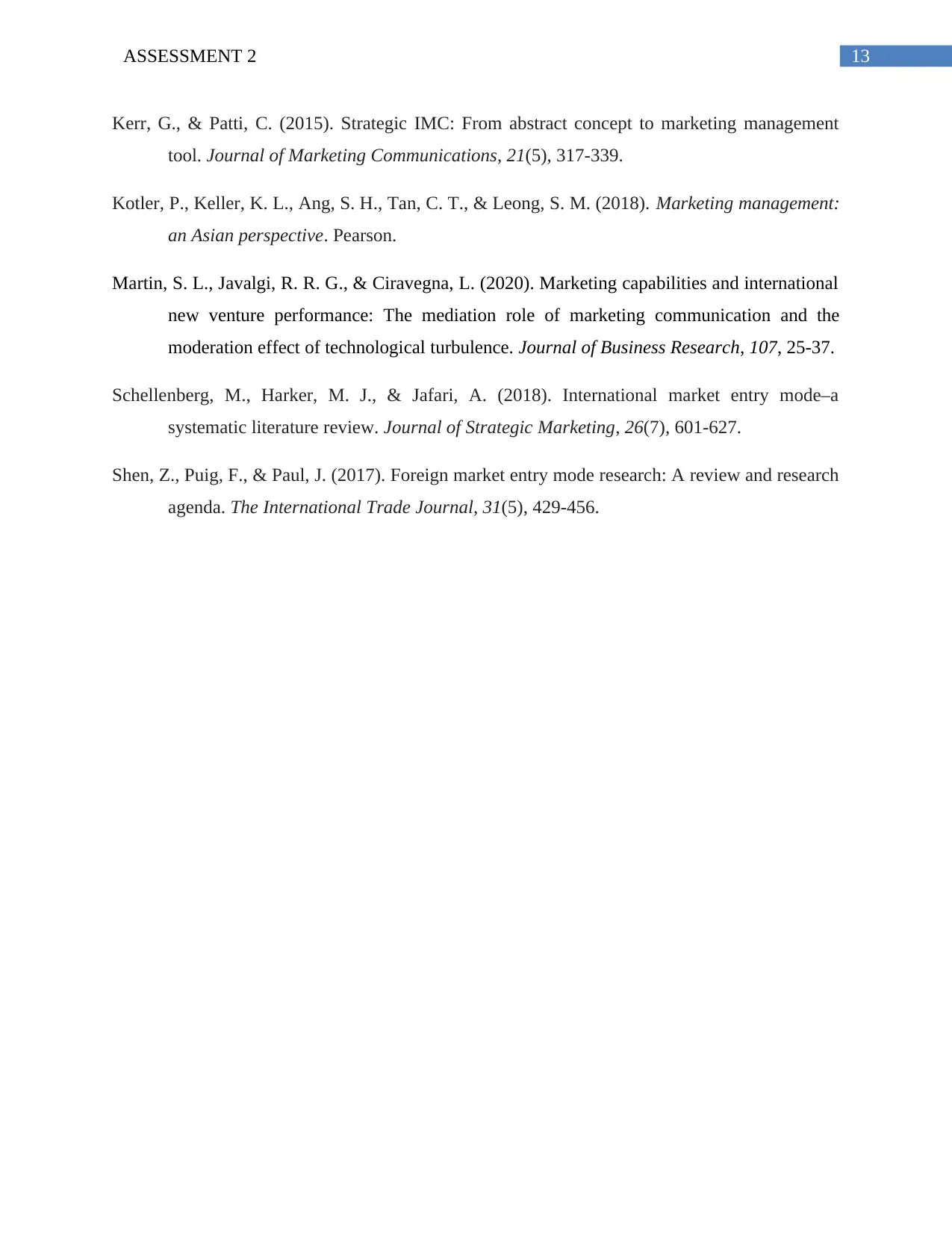
13ASSESSMENT 2
Kerr, G., & Patti, C. (2015). Strategic IMC: From abstract concept to marketing management
tool. Journal of Marketing Communications, 21(5), 317-339.
Kotler, P., Keller, K. L., Ang, S. H., Tan, C. T., & Leong, S. M. (2018). Marketing management:
an Asian perspective. Pearson.
Martin, S. L., Javalgi, R. R. G., & Ciravegna, L. (2020). Marketing capabilities and international
new venture performance: The mediation role of marketing communication and the
moderation effect of technological turbulence. Journal of Business Research, 107, 25-37.
Schellenberg, M., Harker, M. J., & Jafari, A. (2018). International market entry mode–a
systematic literature review. Journal of Strategic Marketing, 26(7), 601-627.
Shen, Z., Puig, F., & Paul, J. (2017). Foreign market entry mode research: A review and research
agenda. The International Trade Journal, 31(5), 429-456.
Kerr, G., & Patti, C. (2015). Strategic IMC: From abstract concept to marketing management
tool. Journal of Marketing Communications, 21(5), 317-339.
Kotler, P., Keller, K. L., Ang, S. H., Tan, C. T., & Leong, S. M. (2018). Marketing management:
an Asian perspective. Pearson.
Martin, S. L., Javalgi, R. R. G., & Ciravegna, L. (2020). Marketing capabilities and international
new venture performance: The mediation role of marketing communication and the
moderation effect of technological turbulence. Journal of Business Research, 107, 25-37.
Schellenberg, M., Harker, M. J., & Jafari, A. (2018). International market entry mode–a
systematic literature review. Journal of Strategic Marketing, 26(7), 601-627.
Shen, Z., Puig, F., & Paul, J. (2017). Foreign market entry mode research: A review and research
agenda. The International Trade Journal, 31(5), 429-456.
1 out of 14
Related Documents
Your All-in-One AI-Powered Toolkit for Academic Success.
+13062052269
info@desklib.com
Available 24*7 on WhatsApp / Email
![[object Object]](/_next/static/media/star-bottom.7253800d.svg)
Unlock your academic potential
© 2024 | Zucol Services PVT LTD | All rights reserved.




